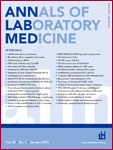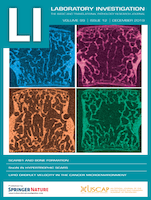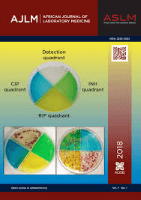
ANNALES DE BIOLOGIE CLINIQUE
Scope & Guideline
Exploring the Depths of Biochemistry and Beyond
Introduction
Aims and Scopes
- Clinical Diagnostics and Biomarkers:
The journal frequently publishes studies on novel biomarkers for various diseases, emphasizing their diagnostic and prognostic significance in clinical settings. - Laboratory Techniques and Innovations:
Research on advancements in laboratory techniques, including point-of-care testing, automation, and the integration of artificial intelligence in diagnostics, is a central theme. - Infectious Diseases and Immunology:
A significant portion of the journal's articles focuses on the diagnosis, management, and laboratory findings related to infectious diseases and immunological disorders. - Toxicology and Pharmacology:
The journal explores the toxicological aspects of various substances, including synthetic cannabinoids and the impact of medications on laboratory results. - Health Services and Quality Management:
There is a consistent emphasis on quality control, laboratory management practices, and the integration of new technologies to improve healthcare delivery.
Trending and Emerging
- Artificial Intelligence in Diagnostics:
There is a growing trend towards the integration of artificial intelligence and machine learning in diagnostic processes, enhancing predictive capabilities and operational efficiency. - Personalized Medicine and Genomics:
Emerging research focuses on personalized medicine approaches, including the use of genetic and genomic data to tailor treatment strategies for individual patients. - Point-of-Care Testing Innovations:
The development and evaluation of portable and rapid diagnostic tests that can be used at the point of care are increasingly emphasized, especially in emergency and remote settings. - Impact of COVID-19 on Clinical Practice:
Research related to the implications of the COVID-19 pandemic on laboratory practices, diagnostic testing, and the management of infectious diseases has surged, reflecting its ongoing relevance. - Quality Control and Laboratory Management:
There is a notable increase in studies addressing quality control measures, laboratory accreditation, and management strategies to enhance the reliability of laboratory results.
Declining or Waning
- Traditional Diagnostic Methods:
There is a noticeable decrease in publications focused solely on traditional diagnostic methods, as the field moves towards more innovative and automated techniques. - General Pathology Reports:
Case reports and reviews that do not incorporate novel findings or advancements in methodology are becoming less common, as the journal seeks to prioritize impactful research. - Basic Laboratory Techniques:
Articles that focus exclusively on basic laboratory techniques without application to clinical outcomes or advancements in technology are being phased out in favor of more clinically relevant studies.
Similar Journals

JOURNAL OF CLINICAL PATHOLOGY
Connecting Evidence to Effective TreatmentJOURNAL OF CLINICAL PATHOLOGY, published by BMJ PUBLISHING GROUP, stands at the forefront of advancements in the field of clinical pathology, offering a platform for groundbreaking research and insights from 1948 to the present. With an impressive impact factor and categorized as Q1 in both Medicine (miscellaneous) and Pathology and Forensic Medicine for 2023, the journal holds a distinguished position in the academic community, ranking 22nd out of 208 journals in its category on Scopus and representing the 89th percentile. While the journal does not currently offer open access, it remains a vital resource for researchers, healthcare professionals, and students seeking to stay current with innovative methodologies, clinical techniques, and diagnostic advancements. Located in London, United Kingdom, the journal aims to bridge the gap between laboratory findings and clinical practice, emphasizing the importance of evidence-based pathology in improving patient care and treatment outcomes. Engage with the JOURNAL OF CLINICAL PATHOLOGY to enhance your understanding and contribute to the evolving landscape of clinical pathology research.

Annals of Laboratory Medicine
Empowering Research, Elevating Patient CareAnnals of Laboratory Medicine, published by the KOREAN SOC LABORATORY MEDICINE, stands as a pivotal resource for researchers and practitioners in the fields of clinical and medical biochemistry. With a strong Q2 ranking in both Biochemistry (medical) and Clinical Biochemistry, along with a prestigious Q1 status in miscellaneous Medicine categories, this journal emphasizes the significance of laboratory medicine in improving patient outcomes and advancing scientific understanding. Established in 2012, the journal has demonstrated an impressive trajectory of growth and scholarly contribution, making it a reliable source of high-quality research and insightful reviews. The journal utilizes open access, enhancing the reach of its findings across the global scientific community. Operating from South Korea, Annals of Laboratory Medicine aims to foster dialogue and collaboration among professionals, contributing to the continuous advancement of laboratory methodologies and diagnostics.

IN VIVO
Driving impactful discoveries in the fight against cancer.IN VIVO is a prestigious academic journal published by the International Institute of Anticancer Research, dedicated to advancing the fields of biochemistry, genetics, molecular biology, cancer research, and pharmacology. With its ISSN 0258-851X and E-ISSN 1791-7549, this journal has been a key contributor to innovative research since its inception in 1987, providing a crucial platform for the dissemination of significant findings in its scope. With an impressive impact reflected in its quartile rankings (Q2 in Biochemistry, Genetics and Molecular Biology and Medicine; Q3 in Cancer Research and Pharmacology), IN VIVO reaches a global audience comprising researchers, health professionals, and students. Although it operates on a subscription basis, the journal’s commitment to scientific excellence and rigorous peer review ensures that all published works maintain high quality and relevance. Notably positioned in Scopus ranks within the 36th to 59th percentiles across various categories, IN VIVO continues to be a vital resource for cutting-edge research and developments, solidifying its importance within the scientific community.

LABORATORY INVESTIGATION
Enriching Knowledge in Pathology and Forensic MedicineLaboratory Investigation is a premier academic journal published by Elsevier Science Inc, specializing in the fields of Pathology, Forensic Medicine, Cell Biology, and Molecular Biology. With its ISSN 0023-6837 and E-ISSN 1530-0307, this journal has been a significant contributor to scientific discourse since its inception in 1952, converging into its current form by 2024. It holds an impressive standing in its respective fields, featuring a 2023 Journal Rank of Q2 in both Cell Biology and Molecular Biology, and an elite Q1 ranking in Pathology and Forensic Medicine, reflecting its influence and quality of research, as seen in its Scopus ranks—17th out of 208 in Pathology and Forensic Medicine. Although it does not offer Open Access options, the journal remains a vital resource for researchers, professionals, and students who seek to disseminate and engage with high-caliber research findings. The importance of Laboratory Investigation is underscored by its commitment to advancing the understanding of laboratory and translational medicine, paving the way for innovations that enhance clinical practices.

CRITICAL REVIEWS IN CLINICAL LABORATORY SCIENCES
Exploring the Frontiers of Laboratory ResearchCRITICAL REVIEWS IN CLINICAL LABORATORY SCIENCES, published by Taylor & Francis Ltd, stands as a premier journal in the field of clinical laboratory science, addressing pivotal advancements and challenges since its inception in 1970. With a commendable impact factor derived from its ranking in Q1 categories across multiple disciplines—including Biochemistry, Genetics and Molecular Biology, and Clinical Biochemistry—this journal is a critical resource for researchers, clinicians, and educators aiming to deepen their understanding and application of laboratory science. The journal's rigorous peer-review process ensures that only the highest quality research is published, providing a platform for profound discussions that influence laboratory practices globally. Although not an open-access journal, it offers various subscription options to facilitate access to its wealth of knowledge. Operating out of Abingdon, England, CRITICAL REVIEWS IN CLINICAL LABORATORY SCIENCES continues to shape the future of clinical biochemistry and laboratory research through its insightful articles, systematic reviews, and expert commentaries, making it an essential read for professionals eager to stay at the forefront of their field.

Biochemia Medica
Elevating Knowledge in Medical BiochemistryBiochemia Medica is a premier open-access journal that has been at the forefront of advancing knowledge in the fields of medical biochemistry and laboratory medicine since its inception in 2006. Published by the Croatian Society of Medical Biochemistry & Laboratory Medicine, this journal serves a vital role in disseminating high-quality research findings and reviews that contribute to the understanding of biochemical processes in health and disease. With an impressive performance in the Scopus ranking, it holds a Q2 quartile category in both medical biochemistry and clinical biochemistry for 2023, reflecting its commitment to scholarly excellence and relevance in the field. As an open-access journal, Biochemia Medica ensures that research is freely accessible, fostering collaboration and innovation among researchers, healthcare professionals, and students globally. Positioned within a rapidly evolving scientific landscape, this journal is dedicated to bridging the gap between laboratory research and clinical application, making it an indispensable resource for anyone interested in the intersections of biochemistry and medicine.

Recent Advances in Inflammation & Allergy Drug Discovery
Bridging the gap between research and real-world applications.Recent Advances in Inflammation & Allergy Drug Discovery, published by Bentham Science Publishers Ltd, is an esteemed open-access journal dedicated to the dynamic fields of drug discovery, immunology, and allergy. Since its inception in 2021, this journal has emerged as a crucial platform for disseminating groundbreaking research and innovative methodologies that drive forward our understanding of inflammatory processes and allergic diseases. With an ISSN of 2772-2708 and an E-ISSN of 2772-2716, it is currently indexed in various categories, boasting a Q3 ranking in Drug Discovery and Immunology & Allergy, and a Q1 ranking in Medicine (miscellaneous) for 2022. Operating from the United Arab Emirates, the journal aims to bridge the gap between laboratory research and clinical application, offering a comprehensive collection of articles that are accessible to a broad audience. Through its commitment to open access, it ensures that critical findings are widely available, fostering collaboration and innovation among researchers, practitioners, and students alike. Join the scholarly community engaged in this vital area of research and contribute to the ongoing advancements in inflammation and allergy therapeutics.

JOURNAL OF BIOMEDICAL SCIENCE
Exploring the frontiers of biomedical science for global impact.JOURNAL OF BIOMEDICAL SCIENCE, published by BMC, is a premier Open Access journal dedicated to the rapid dissemination of research in the fields of biomedical science, encompassing crucial areas such as biochemistry, cell biology, clinical biochemistry, and more. Since its inception in 1993, the journal has established itself as a leading publication, currently boasting a remarkable impact factor and quality as evidenced by its Q1 quartile rankings across multiple categories in 2023. With an impressive track record, including a Scopus ranking in the top percentiles across several disciplines, it serves as a vital resource for researchers, professionals, and students who are keen on advancing their knowledge in biomedicine. The journal operates under a fully Open Access model, ensuring that all published articles are freely available to the global research community, thus contributing to the broader dissemination and accessibility of scientific knowledge. Based in the United Kingdom, JOURNAL OF BIOMEDICAL SCIENCE is committed to fostering innovation and collaboration in research, appealing to those aiming to make impactful contributions to the biomedical sphere.

African Journal of Laboratory Medicine
Enriching public health through shared knowledge.The African Journal of Laboratory Medicine, ISSN 2225-2002, e-ISSN 2225-2010, is a premier publication dedicated to advancing the field of laboratory medicine within the African context. Published by AOSIS since 2012, this Open Access journal aims to disseminate influential research findings, clinical studies, and innovative techniques in the realms of Clinical Biochemistry, Medical Laboratory Technology, and Public Health. Based in South Africa, the journal not only serves as a critical platform for sharing knowledge and best practices but also plays a significant role in fostering public health discussions relevant to the continent. Over the years, it has established itself with impactful rankings in various categories, including a Q4 in Clinical Biochemistry and Q3 in both Medical Laboratory Technology and Public Health. As such, it caters to a diverse audience of researchers, professionals, and students eager to stay at the forefront of laboratory medicine research and its applications. The journal’s commitment to quality and accessibility positions it as an essential resource for those looking to make a significant impact in their respective fields.

EXPERT REVIEW OF MOLECULAR DIAGNOSTICS
Connecting Experts for Groundbreaking DiscoveriesEXPERT REVIEW OF MOLECULAR DIAGNOSTICS, published by Taylor & Francis AS, serves as a pivotal platform for facilitating advanced research and discourse in the fields of Genetics, Molecular Biology, Molecular Medicine, and Pathology. With an impressive Impact Factor and a distinguished status as Q2 in multiple categories, along with a prestigious Q1 ranking in Pathology and Forensic Medicine (2023), this journal continues to attract contributions from leading experts and budding researchers alike. The journal aims to address critical developments in molecular diagnostics, providing insightful reviews that propel the understanding and application of diagnostic techniques in various medical contexts. Accessible to a diverse audience in the academic community, the journal emphasizes the importance of molecular diagnostics in both clinical and laboratory settings, promoting innovative methodologies and comprehensive evaluations of emerging technologies. With ongoing convergence of scientific discovery advancing rapidly from 2001 through 2024, EXPERT REVIEW OF MOLECULAR DIAGNOSTICS remains essential for those committed to furthering the fields of molecular diagnostics and healthcare advancements globally.